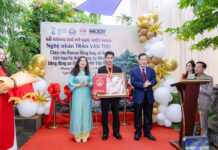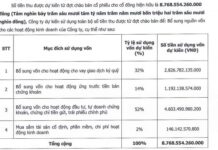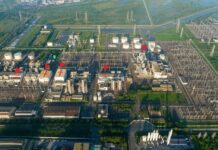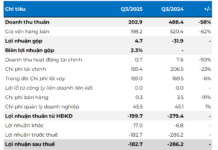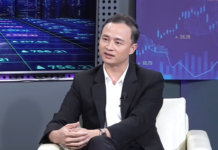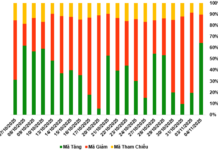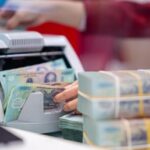
The National Assembly voted to approve the Resolution on investment policy for the high-speed North-South railway project
Prior to the vote, the National Assembly heard Mr. Le Hong Thanh, Chairman of the National Assembly’s Economic Committee, present a summary report on the absorption, refinement, and explanation of the investment policy for the high-speed North-South railway project.
Mr. Le Hong Thanh stated that the majority of opinions agreed on the necessity of investing in the high-speed North-South railway project. The investment in this project plays a crucial role in realizing the Party’s guidelines and the State’s policies, creating a breakthrough in socio-economic development, and modernizing transportation infrastructure.
Some opinions suggested thoroughly calculating all factors and risks to devise feasible solutions suitable for Vietnam’s conditions.
The NA Standing Committee agreed with the majority of deputies’ opinions on the necessity of investing in the project. In reality, the project has been studied and prepared for investment for a long time (approximately 18 years), and experiences from several countries with high-speed railways have been referenced to perfect the pre-feasibility study report. This report included analyses and calculations that predicted transportation demand, and Vietnam’s current potential and position as favorable conditions for implementing the investment project.
Simultaneously, the competent authority thoroughly discussed the investment policy and the factors and conditions for project implementation. However, the calculations in the pre-feasibility study phase are still preliminary. Therefore, it is requested that in the project’s feasibility study phase, the Government directs relevant agencies to continue making specific calculations and thoroughly assessing factors and risks to devise appropriate solutions to ensure the project’s feasibility.
Regarding the investment scope, scale, and preliminary design options, some opinions suggested extending the project’s scope from Lang Son to Ca Mau and implementing it in phases. They also requested connecting the project to the Ho Chi Minh City-Can Tho railway line to ensure synchronization.
According to the NA Standing Committee, the Railway Network Planning for the period of 2021-2030, with a vision towards 2050, has determined the development of new railway routes from Lang Son to Can Tho, comprising three sections: Lang Son (Dong Dang) – Hanoi, Hanoi – Ho Chi Minh City, and Ho Chi Minh City – Can Tho. These sections aim to connect dynamic regions, cities, and major economic centers while ensuring national defense and security along the North-South economic corridor.
Since the railway sections from Lang Son to Can Tho have varying transport demands, the technical standards and types of railways are also different. They are being studied for investment as independent projects, suitable for the transport demand of each section and the capacity to mobilize resources. The Lang Son – Hanoi section, 156 km long, will be a standard railway, with detailed planning currently under study and expected to be invested in before 2030. The Hanoi – Ho Chi Minh City section, 1,541 km long, will be a high-speed railway, with construction expected to commence in 2027. The Ho Chi Minh City – Can Tho section, 174 km long, will be a standard railway, with investment preparation underway and expected to be implemented before 2030.
Regarding the project’s socio-economic and financial efficiency, some opinions suggested thoroughly assessing financial efficiency, especially capital recovery and repayment capabilities, and the need for subsidies during the operation and exploitation of the project.
According to the NA Standing Committee, the Government has calculated significant direct and indirect economic benefits, but they cannot be included in the project’s revenue and financial efficiency. Similar to models in other countries, railway projects bring substantial benefits to the economy, but the calculated revenue for project repayment mainly comes from transportation and commercial exploitation to balance the costs of vehicle operation, maintenance, infrastructure maintenance, and infrastructure fees paid to the State.
Accordingly, in the first four years of operation, revenue will only offset the costs of vehicle operation and maintenance. Therefore, the State needs to provide partial support from the economic affairs capital allocated for the railway system, as is currently done, for infrastructure maintenance.
Concerning the project’s capital sources, many opinions suggested a more comprehensive assessment of capital sources and the ability to balance, allocate, and plan capital for each phase of the project to ensure feasibility and effectiveness. They also recommended a thorough evaluation of the project’s impact on the state budget deficit, public debt, and the budget’s ability to repay debts in the medium and long term.
Some opinions stated that since the project spans three medium-term periods, the total investment approved for each phase should only be calculated for that phase. The capital implemented in each phase should be calculated in that medium-term period and not transferred from the previous medium-term period to the next.
According to the NA Standing Committee, the project spans three medium-term periods, and the capital balance, allocation, and planning for its implementation are as follows: for the 2021-2025 period, the capital demand for the project is approximately VND 538 billion (used for investment preparation) and has been balanced in the medium-term public investment plan of the Ministry of Transport. For the 2026-2030 period, the capital demand is about VND 841,707 billion, and for the 2031-2035 period, the capital demand is approximately VND 871,302 billion.
According to the Law on Public Investment in 2019, the assessment of capital balance capability can only be conducted according to the medium-term public investment plan for five years, with the transition to the next phase not exceeding 20% of the previous phase’s public investment plan. Since the project spans three medium-term periods, there are no regulations regarding the determination of capital balance capability.
Therefore, the draft Resolution stipulates that the project will be allocated capital through the medium-term public investment plans, with the capital allocation for each period matching the project’s progress and without the need for capital balance capability assessment as per the Law on Public Investment.
Permission to Apply Certain Special Mechanisms and Policies
Regarding special mechanisms and policies, especially for implementing the investment project, many opinions emphasized the project’s crucial and long-term strategic role and its profound and broad impact on all aspects of the country’s socio-economic life. They also highlighted its vast scale, complex technical requirements, and the fact that it will be implemented in Vietnam for the first time. Therefore, allowing the application of certain special mechanisms and policies is highly necessary to ensure the project’s feasibility and effectiveness.
The NA Standing Committee agreed with the opinions of the deputies and directed relevant agencies to review and finalize the special mechanisms and policies to ensure feasibility and effectiveness in implementing the project.
Simultaneously, the Government was assigned to issue a Decree guiding the implementation of these mechanisms and policies in detail. During the implementation process, if there is a need to supplement or adjust the special mechanisms and policies, the Government will submit them to the National Assembly and the NA Standing Committee for consideration and decision.
Regarding Policy 7, some opinions suggested establishing a separate policy on technology mastery and operation and exploitation of the project upon completion.
According to the NA Standing Committee, human resource training is a comprehensive and synchronized program implemented over a long period, from the research phase to the future operation and exploitation phases. The total human resource demand is estimated at 227,670 people.
Simultaneously, Policy 8 on industrial development and technology transfer is suitable for the conditions and level of Vietnam’s railway industry.
Establishing a separate policy on technology mastery and operation and exploitation of the project upon completion would disrupt the linkage of a comprehensive program. Since each content, from management to design, construction, operation, and exploitation, is interconnected, the draft Resolution is maintained.
Additionally, Mr. Le Hong Thanh stated that specific opinions had been explained and absorbed in the full report. The NA Standing Committee also directed the absorption of opinions, reviewed, and finalized the Resolution’s technical content.
The Magical Honda Super Cub: A Disney-inspired Edition for the Vietnamese Market
Introducing the Honda Super Cub Disney – an iconic motorcycle that is now being offered for sale by a private importer in Vietnam at a price that surpasses that of a new SH 350i. With its unique design and collaboration with Disney, this Super Cub is a rare find and a true collector’s item. Step back in time with this classic bike, featuring a charming Disney-themed design that is sure to captivate both motorcycle and Disney enthusiasts alike.
“The Speaker’s Call to Action: Expediting the Creation of a Legal Framework for Emerging Issues to Catalyze Vietnam’s Development”
After 29 and a half days of diligent, scientific, democratic, and responsible work, with a spirit of innovation and a timely resolution of difficulties, bottlenecks, and blockages, the 8th Session of the 15th National Assembly has successfully concluded, having accomplished all its proposed agenda items. This session was marked by a strong focus on economic and social development, national defense, security, and improving the lives of the people.
The Heavenly Harvest: Vietnam’s Native Produce Sells Like Hot Cakes in Ukraine, With a Scorching 1,500% Export Increase, Ranking our Country the Third-Largest Producer Globally.
This product has been a cash cow for Vietnam, raking in a whopping $4.8 billion in exports since the start of the year.


